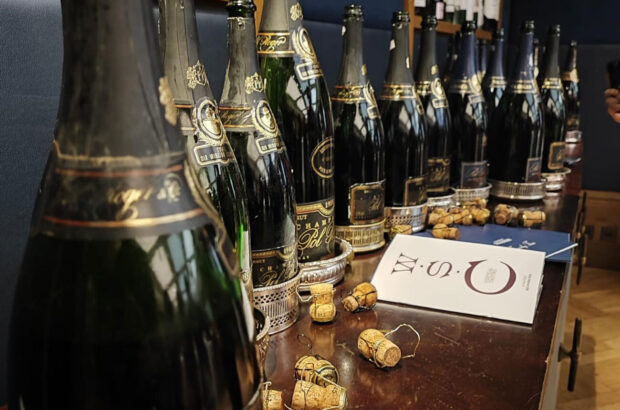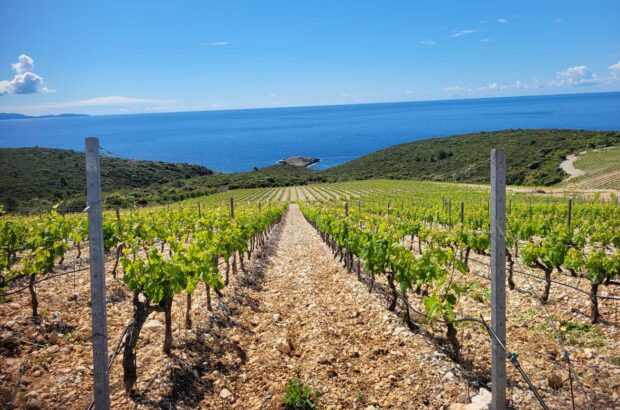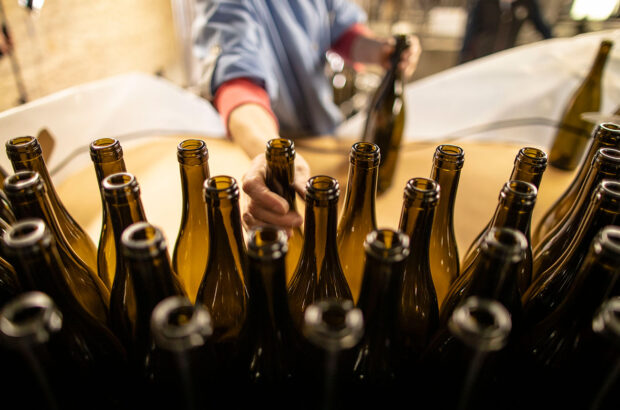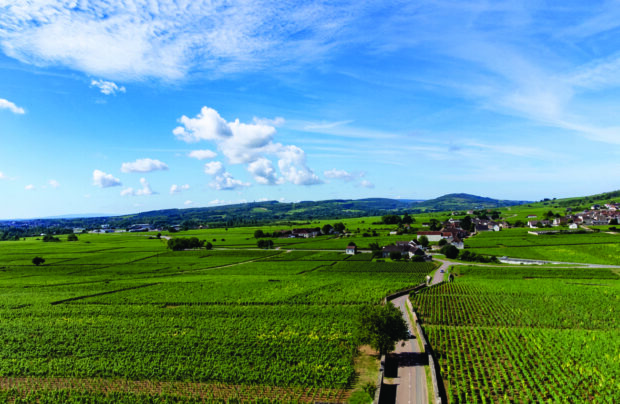US-born Amber Mihna, global sales director for Napa’s Staglin Family Vineyard, met her British partner Phil Robertson, a senior executive at Amazon, in Mexico, in 2020. Since then, they’ve bought a property in the Cotswolds, planted a vineyard from scratch and will produce their first wines under the Fossebridge Vineyard label in 2025. All while holding down their demanding day jobs. They’re even finding time to grow vegetables, and keep bees.
Amber: ‘We met on the day that the news broke about the Covid situation in China, in February 2020. Phil was on holiday in Mexico, and I was there to host a Staglin wine dinner. I was supposed to be travelling on to Europe for the Prowein trade show and other meetings, but everyone started cancelling. Phil went back to Seattle, where he lived at the time; I flew back to my home in Napa. Because all my work travel plans had been cancelled, I drove up to see him and we toured Walla Walla. I started doing the 14-hour drive up there every other week for about six months. There was no traffic on the road, just Amazon and Walmart trucks. In early June, Phil had a visa issue and got sent back to the UK. The international border lockdown meant foreigners couldn’t fly into the US. But I was able to fly to the UK.’
DWWA results out 19 June!
Be the first to know: Subscribe to the DWWA newsletter
Phil: ‘Because I was in the process of moving, with all my stuff stuck in a container somewhere, I was legally allowed to stay in tourist accommodation. Amber would fly over and we toured around southern England: Somerset, the New Forest, the Cotswolds here in Gloucestershire. We wanted to find a house, and we had also both dreamed about owning a vineyard. Amber had even travelled to Piedmont and Tuscany looking for vineyards. While staying near here, we saw Fossebridge House advertised for sale in Cotswold Life magazine. We’d looked in Devon and Sussex also, but fell in love with this house, and the location in the Cotswolds, mainly as a place to live. Built in the 1950s, it hadn’t been decorated since the 1970s and was a complete wreck. But it wasn’t listed so we had the freedom to do the renovations we wanted to.’
Amber: ‘The house came with 3ha and we now have around half of it under vine. It was a massive clearance job – there were stinging nettles up to waist level, and we had to remove 100 tonnes of wood from the trees. You have to apply for change of use if the vineyard is 2ha or above, but ours was smaller so that wasn’t necessary. We carried out soil tests, mainly to make sure there was nothing toxic in the soils – all was fine. Then we did some soil samples. The soil is the commonly found Cotswold brash, a limestone soil with high stone content, with clay and sand, over rock. The vines are on a south-facing slope behind the house, so ideal orientation.’
Phil: ‘Through word of mouth, we came across a guy who had run Biddenden winery in Kent and has now set up a vineyard establishment business. He sourced the vines for us, from France and Germany, and planted them. We planted Chardonnay and Pinot Noir in 2021, and then in 2023 more Chardonnay, some Pinot Meunier and Sauvignon Blanc. The Sauvignon Blanc was a late addition, inspired by the success of nearby Woodchester Valley Vineyard with its award-winning SB. It helps to have a still wine, to generate a bit of revenue while your sparkling wines are ageing on lees. We’re also planning to make a Pinot Noir rosé. The sparkling line-up will comprise a non-vintage cuvée, a richer, nuttier blanc de blancs with more time on lees, and a 100% Pinot Meunier.’
Amber: ‘We decided not to plant PiWi (fungus-resistant) varieties. Lots of people round here have planted them and do well with them, and they undoubtedly cope better with frost and mildew. But for me, drinking wine means vitis vinifera. You don’t find much Chardonnay in Gloucestershire, as it’s harder to ripen. Most of the local wineries use Seyval Blanc or Solaris for their sparkling wines.’
Phil: ‘The only drawback to the location is that we’re quite high up here for the area, on the Cotswold escarpment, so we do experience frost. Lots of wineries use bougies (paraffin candles). But we’d need around 300, so the cost would be around £3,000 a night. Plus it only gives you 1.5˚ to 2˚C protection, so it doesn’t even work if the temperature falls too low. The other downside is that it’s manual – you have to physically go out and light them all. Not only does that take time – we have 6,000 vines, at 1m spacing – but also we both travel a lot for work, so we needed a remote solution. Amber is on the road around 200 days of the year. We looked at heated wires and infrared lights, but the running costs are very high. So we’ve installed a water-based system, which has high capital costs but lower running costs (about half the cost of lighting bougies over five years), and can be activated remotely. When it gets cold, sprayed water stops the bud from freezing – it’s slightly exothermic (heat creating) – and then encapsulates the bud in a cocoon of ice. You keep spraying so the pipes don’t freeze, and the temperature stays at 0˚C.’
Amber: ‘We also get lots of rain, so mildew is a challenge. Most people reckon you can harvest in your third year from planting, while some advise you wait an extra year. We didn’t have a choice as we hadn’t bought a sprayer last year and had mildew in the leaves and trunks – it rained virtually every day in July and August. We won’t harvest until 2025, but it gives the plants a better base to build from. We’re expecting seven or eight good harvests out of 10, given the marginal climate. It’s getting warmer, but achieving the sugar levels you need, even for sparkling, can be tough, especially when you factor in the altitude here (you lose 0.5˚C for every 50m).’
Phil: ‘It’s expensive starting a vineyard in the UK, and we don’t have investors – we’re bootstrapping it as much as we can. Brexit hasn’t helped in terms of the taxes we need to pay to get equipment purchased from abroad through customs. We get help when we need it, but we do most of the work ourselves, trying to incorporate organic practices wherever we can. We can prune the top vineyard in 20 hours. It’s a killer on the back though. We’re currently looking at winemaking options. In the long term we’d like our own winery here, but in the meantime we’ll use another winery or a contract winemaking firm.’
Amber: ‘Napa feels very different as a winemaking community, as it’s such a small area – 5 miles by 30 miles. And producers have learned to collaborate really well in the face of the recent natural disasters. In contrast, wineries here are spread across the whole of the south of the UK, even extending north to Yorkshire. It’s harder to have a community over that distance. That said, when we needed some more posts urgently we put a shout-out on the WineGB forum, and a winery in Cornwall let us have some they didn’t need, for free. That was a great feeling. The local community here is great too. Initially there was disbelief among the locals that we were planting vines, but now they’re excited. The day that we put the first vines in the ground we had a party, because we wanted everyone to know what was happening. That is paying off.’












